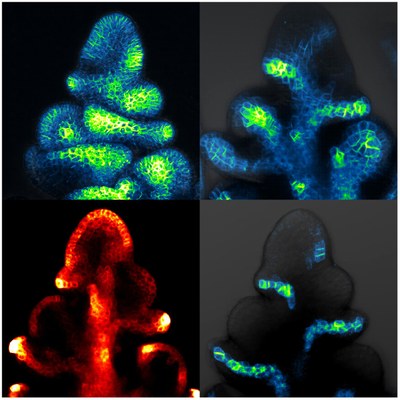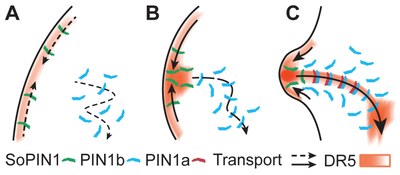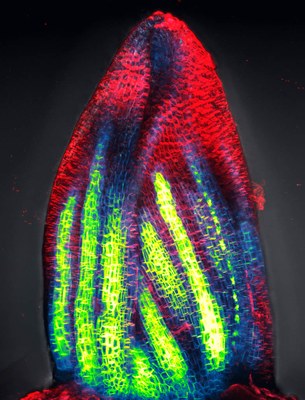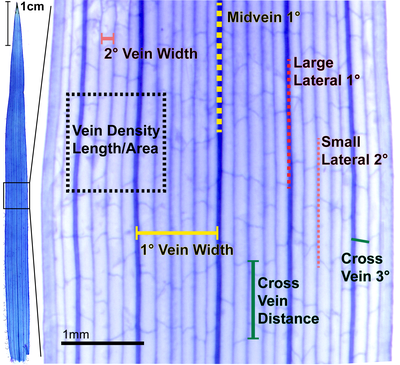Dr O'Connor's Group used both Arabidopsis thaliana and the grass Brachypodium distachyon as model systems to examine three important questions in plant developmental biology: 1) How does transport of the plant hormone auxin control the placement of both new leaves and their vasculature? 2) What are the molecular mechanisms that pattern grass leaves? 3) What are the genes that control the density and plasticity of leaf veins?
1- PIN functional evolution
The cell-to-cell movement of the hormone auxin conveys important positional, polarity, and growth regulatory cues throughout plant development. Because auxin is such a ubiquitous regulator, it is also a key integrator of environmental cues. Numerous computational models and functional studies have explored the pivotal role of the plasma-membrane localized PIN-FORMED1 (PIN1) auxin export protein in the widely studied model plant, Arabidopsis thaliana. These studies have led to several models for how PIN1 polarizes in the cell membrane in response to auxin to create both the convergent polarisation patterns thought necessary to concentrate auxin during leaf initiation and leaf morphogenesis, as well as the narrow polarised streams away from auxin maxima required for vein patterning and branch regulation. Dr O'Connor's Group discovered that most flowering plant species have at least two PIN proteins, Sister-of-PIN1 (SoPIN1) and PIN1, whereas Arabidopsis has only PIN1, and that these two proteins share the functions combined into Arabidopsis PIN1. Dr O'Connor's Group used comparative imaging and genetics in both Arabidopsis and Brachypodium to try and relate changes in PIN gene family structure, protein expression domain, and protein function to determine how PIN polarity is controlled, and how changes in PIN function may relate to morphological diversity.
2 - Blades of grass
Few shapes in the biological world are as important to human survival as the grass leaf. Grasses alone provide more than 50% of human calories world-wide. They constitute 70% of all crops, cover 1/3 of all arable land, and are an important sources of biomass for renewable energy production. While the grass family is the 5th largest of all plants, with diverse species occupying almost every ecological niche on the planet, the shape of all grass leaves is basically the same. The grass leaf is a strap of tissue encircling the stem, with parallel primary veins and a hinge that orients the flattened blade to the sun. The O'Connor Research Group used live-imaging and computer modeling to try and understand the developmental patterning of the grass leaf in an effort to understand the adaptations that have made the grass leaf so evolutionarily and agronomically successful.
3 - Natural variation in Brachypodium leaf vein topology
Leaf vein density relates directly to transpirational efficiency and thus carbon fixation capacity. Accordingly, high leaf vein density is one of the plant traits most correlated with overall photosynthetic rate and yield. However, increases in vein density are a trade-off with reduced photosynthetic tissue and the potential for increased water loss. Thus vein density is a developmentally plastic trait. The O'Connor Group used high-throughput image-based measurement of vein traits and natural genetic variation in Brachypodium to identify and characterise factors controlling leaf vein density and its plasticity.
Key Publications
O'Connor DL, Elton S, Ticchiarelli F, Hsia M, Vogel JP, Leyser OH. 2017. Cross-species functional diversity within the PIN auxin efflux protein family. eLife 2017;6:e31804
Abraham Juárez MJ, Hernández Cárdenas R, Santoyo Villa JN, O’Connor D, Sluis A, Hake S, et al. Functionally different PIN proteins control auxin flux during bulbil development in Agave tequilana. J Exp Bot. 2015. doi:10.1093/jxb/erv191
Bennett TA, Liu MM, Aoyama T, Bierfreund NM, Braun M, Coudert Y, Dennis RJ, O’Connor D, Wang XY, White CD, Decker EL, Reski R, Harrison CJ. Plasma membrane-targeted PIN proteins drive shoot development in a moss. Curr Biol. 2014;24: 2776–2785. doi:10.1016/j.cub.2014.09.054
O'Connor DL, Runions A, Sluis A, Bragg J, Vogel JP, et al. (2014) A Division in PIN-Mediated Auxin Patterning during Organ Initiation in Grasses. PLoS Comput Biol 10(1): e1003447. doi:10.1371/journal.pcbi.1003447
Bolduc N, O'Connor D, Moon J, Lewis M, Hake S (2012) How to Pattern a Leaf. Cold Spring Harbor Symposia on Quantitative Biology. doi:10.1101/sqb.2012.77.014613.
Bolduc N, Yilmaz A, Mejia-Guerra MK, Morohashi K, O'Connor D, Grotewold E, Hake S. 2012. Unraveling the KNOTTED1 regulatory network in maize meristems. Genes Dev 26: 1685–1690.
International Brachypodium Initiative. 2010. Genome sequencing and analysis of the model grass Brachypodium distachyon. Nature 463: 763–768.
Chuck G, O'Connor D. 2010. Small RNAs going the distance during plant development. Curr Opin Plant Biol 13: 40–45.




